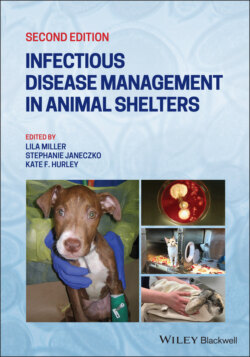Читать книгу Infectious Disease Management in Animal Shelters - Группа авторов - Страница 64
2.7.2 Housing Design Considerations
ОглавлениеThe ASV Guidelines state “poor cat housing is one of the greatest shortcomings observed in shelters and has a substantially negative impact on both health and well‐being.” (ASV 2010). Several recommendations have been made for the appropriate dimensions and configuration of housing for cats in catteries and laboratories, but only a few existed specifically for cats housed in shelters until recently. Some websites that contain guidelines for appropriate housing for cats in shelters, as well as instructions for modifying existing housing, are listed in Table 2.5.
Table 2.5 Resources for cat housing.
| Resource | Website |
|---|---|
| University of Florida | https://sheltermedicine.vetmed.ufl.edu |
| University of California‐ Davis | https://www.sheltermedicine.com |
| University of Wisconsin‐ Madison | https://www.uwsheltermedicine.com |
| Cornell University | https://www.vet.cornell.edu/hospitals/maddies‐shelter‐medicine‐program) |
| Association of Shelter Veterinarians | https://www.sheltervet.org/assets/docs/shelter‐standards. |
| American Society for the Prevention of Cruelty to Animals (ASPCA) | https://www.aspcapro.org |
| Humane Society of the United States (HSUS) | http://www.humanepro.org |
Enclosures for cats should be large enough to allow them to stretch, groom, and move about while maintaining separate functional areas, at least 2 ft apart, for sleeping, eating and elimination. Unfortunately, many animal shelter facilities in the United States are equipped with small cages (e.g. 1.5–2.5 ft wide) that are inadequate for proper housing of cats. Double‐sided enclosures (e.g. cat condos) generally afford more adequate space and have the benefit of easily allowing cats to remain securely in one side of the enclosure while the opposite side is cleaned. Traditional cages can be modified into condo‐style enclosures by creating portals to adjoin two or three smaller cages. See Figure 2.2a and b. Runs can also be used to house cats and are especially useful for co‐housing cats, as well as for stays that exceed two weeks. Larger enclosures allow for better air circulation, which is also an important consideration for control of feline URIs. Regardless of the housing dimensions and arrangement, a variety of elevated resting perches and hiding boxes should be provided to increase the size and complexity of the living space, and to separate it into different functional areas, allowing a variety of behavioral options. The physical environment should always include opportunities for hiding, playing, scratching, climbing, resting, feeding, and eliminating.
For dogs, indoor‐outdoor access is generally preferred, but whatever the arrangement, dogs should be able to see out to observe their environment. While it is important for dogs to see out of their enclosures, enclosures that are arranged side by side should have solid sides to prevent direct contact with dogs in adjacent enclosures, and visual barriers should be provided on the front and back ends of enclosures as needed to shield occupants from stressful stimuli. Outside areas should provide protection from excessive sun, rain and wind. See Figure 2.3. Runs must be large enough to allow a dog to move about freely, and a clean, comfortable bed should be available for resting in a secure location. Double‐sided enclosures are always preferred because they allow dogs to eliminate away from resting and feeding areas. (Though shelters often place dogs on both sides of the enclosure, this practice should be discouraged whenever possible because it defeats the goal of double‐sided housing to provide an easily cleaned, enriched environment.) The addition of three‐dimensional space (such as platforms, steps, or ramps) may be beneficial when space permits (Hubrecht 1993; Loveridge 1998; Overall 2005).
Figure 2.2 (a and b). Conversion of existing cages into condo‐style units can be accomplished via the installation of a portal between cages by cutting a hole through the walls of adjacent cages and installing a section of PVC pipe with corresponding rims.
Figure 2.3 Outdoor section of a row of double‐sided kennel runs. Indoor‐outdoor kennel runs afford dogs with separate areas for resting and elimination. Note that solid sides prevent direct contact among dogs in adjacent runs, while the ends of the runs are partially unobscured to allow occupants to safely look out at their surroundings if they choose to do so.
The success of the adaptation of cats and dogs to novel environments depends on both the quality of the environment and the adaptive capacity of the animal. With proper behavioral wellness protocols in place, most animals will adapt and successfully cope with shelter life in the short term. However, some will never adjust and will remain stressed indefinitely, resulting in the decline of physical as well as emotional health. Novel environments tend to be especially stressful for poorly socialized and geriatric cats and dogs. Geriatric animals generally benefit from placement in foster care. The housing of feral cats should be avoided whenever possible; healthy feral and free‐roaming cats can benefit from appropriately managed neuter and return programs in which healthy cats are vaccinated, surgically sterilized, and returned to their original site of capture (e.g. their home base).
The importance of proper staff training to recognize and prevent stress is critical for animal welfare and cannot be overemphasized. Long‐term behavioral coping is extremely difficult for most animals, thus behavioral deterioration can be expected as LOS increases. This further underscores the importance of employing management strategies that minimize each animal's time in the shelter while maximizing the best outcomes.
